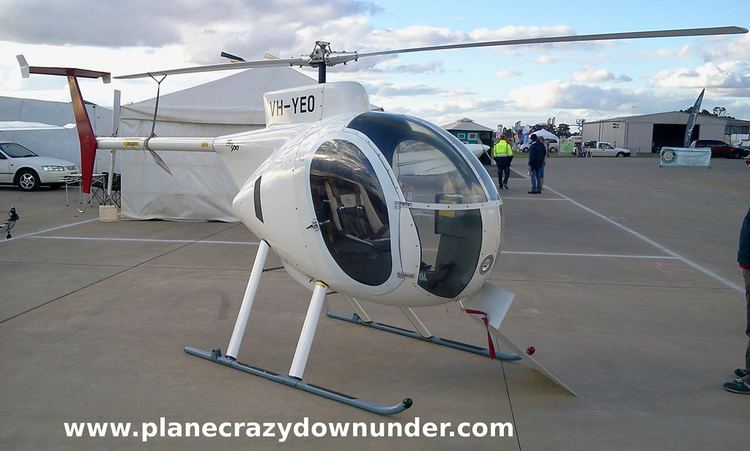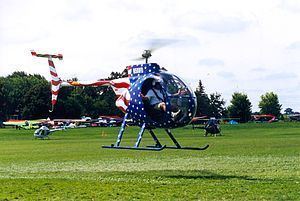Top speed 186 km/h First flight 1992 | Length 6.9 m | |
 | ||
Manufacturer | ||
Revolution mini 500 9th run up hover
The Revolution Mini-500 is a 1990s American single-seat light helicopter, designed and built by Revolution Helicopter Corporation as a kit for homebuilding.
Contents
- Revolution mini 500 9th run up hover
- The latest revolution mini 500 helicopter demo video full length
- Development
- Operational use
- Rotax 582
- Variants
- Specifications
- References

Revolution Helicopter went out of business in November 1999 and kits are no longer available.
The latest revolution mini 500 helicopter demo video full length
Development

The Mini-500 was designed as a light helicopter that resembles a scaled-down Hughes 500, powered by a Rotax 582 64 hp (48 kW) two-stroke engine.

The Mini-500 design was initially based upon Augusto Cicaré's control system design as incorporated in his CH-6 prototype helicopter, but Fetters and Cicaré were unable to agree on licensing terms. Fetters instead elected to design and patent a "newly improved control system".

The Mini-500 has a tubular steel fuselage with a foam and glass-fibre structure cabin. It has a two-bladed semi-rigid rotor and a conventional two-blade tail rotor. The first Mini-500 flew in 1992 and the company delivered the first production factory-assembled helicopter in July 1994. Production of kits ceased in 1999 and the company claimed that more than 500 had been sold.

The factory advertised the kits, saying: "no machining, welding or cutting is required and the package includes pre-drilled guide holes for easy alignment during construction ... pre-fabricated, lightweight superstructure with all complicated components pre-assembled at the factory, i.e., upper main transmission/reduction with rotor head, instrumentation panel, and tail rotor gear box assembly)." Also included in the kit were the composite cabin structure, doors, transmission cover and horizontal stabilizer.
The initial kit price was US$24,500 and included the Rotax 582 powerplant, fiberglass enclosure, basic instrumentation, electric starter, landing lights and navigation lights. The components came pre-painted in a variety of optional colors. The composite tail and main rotor blades were advertised as “lifetime on condition", indicating no fixed lifespan. Assembly time was advertised as 40 hours.
After Revolution Helicopter ceased operations, there was an attempt in 2003 led by Richard Stitt and Stitt Industries, Inc. to restart production of the Mini-500. The company started providing replacement engines to existing Mini-500 owners to replace the under-powered Rotax 582s and intended to produce new Mini-500s. Initial intentions were that it would be powered by a Mazda Wankel engine, but this was abandoned and plans shifted to the Solar T62 turbine engine. There is no indication that Stitt delivered any aircraft kits.
Operational use
It is unclear how may Mini-500s have been built, with the company claiming to have sold over 500 Mini-500s kits with more than 400 built and flown, it has also been claimed by critics that no more than a 100 have been actually built and flown. On 10 February 2010, 172 Mini-500s remained on the Federal Aviation Administration registry, with an additional 81 registrations cancelled. (Although registered, this does not indicate these aircraft have flown.)
Of those that did fly there were many component failures, dozens of accidents and incidents and nine fatalities. The aircraft quickly developed a poor safety reputation and this curtailed kit sales.
The Rotax 582 two stroke engine proved to be underpowered in this application and many failed in flight. The engine's vibration levels also proved to be a problem as they, combined with excessive rotor vibrations, lead to cracked frames and other component failures.
Owners complained that the aircraft was not well designed. The president of the International Experimental Helicopter Association, the Mini-500 aircraft type club, Bill Phillips, who completed a kit, but did not fly it stated: "You can tell it is junk just by looking at it" and described Revolution Helicopter Corporation president Dennis Fetters as "one of the biggest cons that’s ever hit the kit industry".
Fetters strongly denied that the design had safety issues and issued statements indicating that all accidents were due to improper maintenance, failure of builders to carry out rotor tracking and balancing or lack of piloting skills. In response to customer complaints in 1998 Fetters did add a tuned exhaust system to increase engine output, stronger transmission gears and a mast support kit to reduce vibrations.
Rotax 582
Engine manufacturer Rotax warns owners of the 582 engine in the Owners Manual about its limitations:
Variants
Specifications
Data from Taylor and Southeast Recreational Helicopters
General characteristics
Performance
